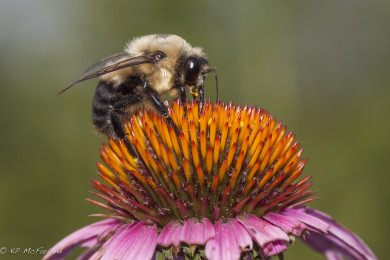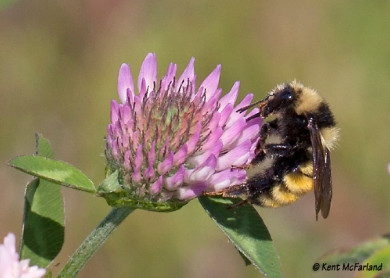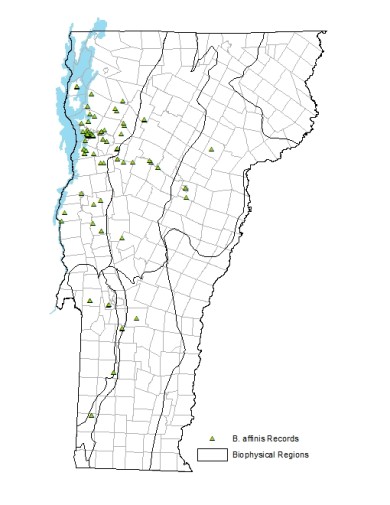The Vermont Bumble Bee Atlas aimed to document the past and current relative abundance and distribution of bumble bees (Bombus) as well as the Eastern Carpenter Bee (Xylocopa virginica) across the state.
Bumble bees, familiar and flashy insects, are silent messengers of environmental conditions. They respond to changing land use practices and other human-induced pressures. Yet we knew so little about the bumble bees of Vermont. There was no statewide data bank, no atlas of their distribution, no scientific assessment of the threats they faced, and no conservation concept for bee species statewide. With this in mind, the Vermont Center for Ecostudies initiated the Vermont Bumble Bee Atlas in 2012.
The project’s major objectives were to:
- Publish on the Internet maps and data about the historic and present distribution of Vermont bumble bees.
- Obtain a baseline of bumble bee distribution at the beginning of this century for comparison in the future.
- Assess the conservation status and needs of Vermont bumble bee species.
- Identify habitats of statewide and regional importance.
- Educate and involve more people in the discovery and protection of Vermont’s natural heritage.
The survey makes essential data available to landowners, land-use planners, policy-makers, municipalities, and other individuals or organizations responsible for conservation and management decisions. This atlas is closely modeled after the recently completed Vermont Butterfly Survey. Our results will allow direct comparisons among states, with scientific and conservation implications extending throughout the Northeast and beyond. In short, this project offers the opportunity for individuals, either professional or amateur, to make a significant contribution to the greater understanding Vermont’s natural heritage.
Vital Pollinators
Pollination services provided by native insects, mostly bees, are estimated at $3 billion per year in the United States. For some crops native bumble bees pollinate more effectively than European honeybees, in part because they fly in cooler temperatures and lower light levels. Bumble bees are “buzz” pollinators. The bee grabs the stamen and vibrates her wing muscles causing pollen to fall. This is highly effective for the cross-pollination of tomatoes, peppers, cranberries, and blueberries. Losses of native bees can have far-ranging ecological impacts due to their role as pollinators. In Britain and the Netherlands, where several bee species have gone extinct, there is evidence of a decline in the abundance of insect-pollinated plants.
Bumble bees are silent messengers of environmental health. Because individual species may have specific habitat requirements, bumblebees can speak volumes about the state of the environment. There is widespread understanding that pollinators are at serious risk or in decline due to habitat change and loss, pollution, and climate change. Pollinators are critical for both wild and cultivated plants. Bumble bees are highly sensitive to pesticides and even climate change. Despite the ecological and economic importance of bumblebees and our dependence on them, we have little baseline information on distribution, rarity, and habitat needs in Vermont.
In the late 1990s, biologists noticed a decline in the abundance and distribution of bumblebee species worldwide. In the Northeast, there appeared to be a sudden, range-wide population decline of several species. For example, the Rusty-patched Bumble Bee (Bombus affinis), a pollinator of wildflowers, cranberries, and other crops, was commonly collected by University of Vermont students as recently as the early 1990s. Not a single specimen has been found in Vermont since the late 1990s. What was among the most common bumble bee of fields, farms, and gardens, has disappeared from our state in the span of a decade or less.
There is hope. Small numbers of Rusty-patched Bumble bees have recently been found in isolated areas primarily in the northern part of the species’ range. Can we still find remnant, isolated populations in Vermont to conserve and even perhaps restore the species?
Sponsors and Support
The Vermont Bumble Bee Atlas is sponsored by the Vermont Center for Ecostudies (VCE) with financial support from the Binnacle Family Foundation, the Riverledge Foundation and the Vermont Fish and Wildlife Department.
Staff and Advisors
Kent McFarland, Survey Director, Vermont Center for Ecostudies
Spencer Hardy, Survey Biologist, Vermont Center for Ecostudies
Leif Richardson, Survey Biologist, University of Vermont
Sara Zahendra, Survey Coordinator, Vermont Center for Ecostudies
Sam Droege, Advisor, USGS Patuxent Wildlife Research Center
Atlas Manual
A manual was written that described to citizen scientists how to join and survey bumble bees for the atlas.
McFarland, Kent (2018). Vermont Bumble Bee Survey – Manual for Participants. figshare. https://doi.org/10.6084/m9.figshare.6327230.v1









